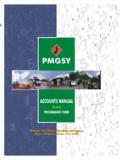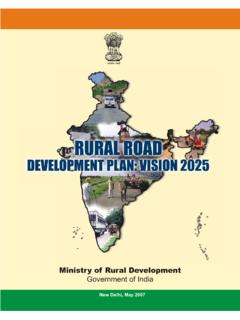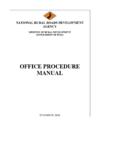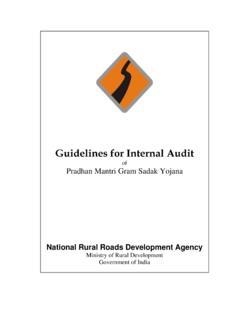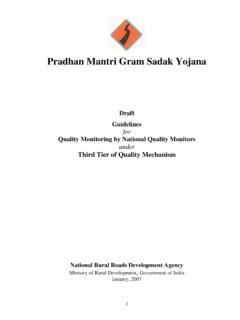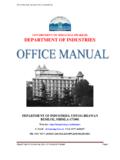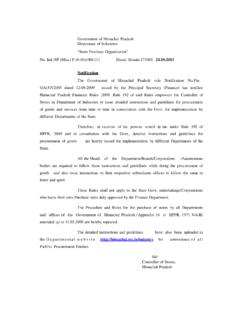Transcription of PRADHAN MANTRI GRAM SADAK YOJANA
1 ACCOUNTS MANUAL OF THE PRADHAN MANTRI gram SADAK YOJANA PART-I PROGRAMME FUNDS PREPARED FOR NATIONAL RURAL ROADS DEVELOPMENT AGENCY, NEW DELHI INSTITUTE OF public AUDITORS OF INDIA New Delhi JULY 2004 Manual for PMGSY Accounting System Page 2 Part I Programme Funds Dated 10th July, 2004 (M P Gupta) Page 2 Manual of PMGSY Accounting System Part I Programme Funds Table of Contents Chapter No. Particulars Subjects covered Preface 2 1 Introduction Guidelines of the PMGSY Hierarchy for the execution of PMGSY State s Share of Costs Execution of Works Maintenance of Rural Roads Flow of Funds Accounting System for the PMGSY Major differences and simibetween the CPWA Code and the PMGSY accounting system 5 2 Opening Balance Sheet, Monthly Account and the Double Entry System Opening Balance Sheet and its format Monthly Account Double Entry System of Accounting Depreciation 15 3 Definitions Define all the technical, finance and accounting terms 19 4 General Outline of the Accounting System Classification of Transactions Chart of Accounts , 25 5.
2 Relations with Accounts Officer Post Check in the Accounts Offices Divisional Accountant Inspection by the Audit Officer/Auditor/Accounts Officers/Internal Auditors Communication of Sanctions to Accounts Officer 31 6 Sanctions General 35 7 Cash Modes of Obtaining Cash Procedure for cancellation of a cheque Receipt of Money _ its Account Procedure Disposal of Receipts Manner of Payment Bills Vouchers 37 Manual for PMGSY Accounting System Page 3 Part I Programme Funds Dated 10th July, 2004 (M P Gupta) Page 3 Cash book Rectification of Errors Cash Verification Imprest Temporary Advance Cheque Books and Receipt Books Custody of Cash 8 Stores General Priced Vocabulary of Stores Quantity Accounts Value Accounts Recoveries for Stock Issued Storage Charge Handling and Other Incidental Charges Valuation of Quantity Accounts Monthly summaries of Stock Receipts and Issues Priced Stores Ledger Adjustment of Profit & Loss on Stock Stock Taking Rectification of Accounts Tools and Plant[MPG1] Road Metal /.
3 Quantity Accounts Schedule of Rates 49 9 Transfer Entries General 62 10 Revenue Receipts General 64 11 Works Accounts Cash Payments Payments to Labourers Payments to Suppliers and Contractors Measurement Books Preparation, Examination & Payment of Bills Aid to Contractors Advance to Contractors Work-Charged Establishment Issue of Materials Ledger of Debit Balances Contractors Account Liabilities Awaiting Incorporation Works Register65 Manual for PMGSY Accounting System Page 4 Part I Programme Funds Dated 10th July, 2004 (M P Gupta) Page 4 Closing the Accounts on Completion of Work Excesses over estimates Correction of Errors after Closing of Accounts Schedule of Rates Contractors' Ledger Scrutiny of Accounts by Contractors 12 Miscellaneous Works Advance Account of Miscellaneous Works Advances.
4 Schedules 91 13 Deposits Repayable Earnest Money/ Security Deposits Sums due to Contractors on Closed Account Accounts of Works Deposits Accounts of Interest-Bearing Securities 92 14 Accounts of Divisional Officers of PIUs Scrutiny of Accounts Bank Reconciliation Statement Monthly Accounts Monthly Balance Sheet Review of Unsettled Accounts Closing the Accounts of the Year 95 15 Accounts of State Rural Roads Development Agency 100 16 Audit Statutory Auditor, namely, Chartered Accountants Comptroller and Auditor General of India Internal Auditort 106 Manual for PMGSY Accounting System Page 5 Part I Programme Funds Dated 10th July, 2004 (M P Gupta) Page 5 Preface Format of the Manual of Accounts for the PMGSY 1. The National Rural Roads Development Agency asked the Institute of public Auditors of India (IPAI) to prepare a manual for the accounting system of PRADHAN MANTRI gram SADAK YOJANA .
5 This is the first draft of the Manual, in following parts: Part I. Programme Funds of PMGSY. Part II Annexure of forms for the PMGSY Programme Funds. Part III Illustrations of the PIU accounts Part IV. Illustrations of the SRRDA accounts Part V Administrative Expenses Fund Accounting System Part VI. Annexure of forms for Administrative Expenses Fund. Part VII Illustrations of the PIU accounts of Administrative Expensive Funds Part IV. Illustrations of the SRRDA accounts of Administrative Expensive Funds 2. IPAI has prepared the first four parts. It invites suggestion, comments from the States and NRRDA on the drafts before finalizing them. Manual for PMGSY Accounting System Page 6 Part I Programme Funds Dated 10th July, 2004 (M P Gupta) Page 6 Chapter 1 Introduction Guidelines The Government of India launched the PRADHAN MANTRI gram SADAK YOJANA (PMGSY) as a 100 percent centrally sponsored scheme on the 25th December, 2000.
6 PMGSY funds come from 50 percent of the cess on high speed diesel (HSD). PMGSY aims to provide good all-weather road connectivity to the unconnected habitations in rural areas by way of an all-weather road with necessary culverts and cross-drainage structures, operable throughout the year. An unconnected habitation means its location is at a distance of at least 500 metres or more ( km of path distance in case of hills) from an all-weather road or a connected habitation. A habitation is not a revenue village or a panchayat. It means cluster of population, living in an area, the location of which does not change over time. Desam, Dhanis, Tolas, Majras, hamlets etc. are commonly used terminology to describe the habitations. The population of all habitations within a radius of 500 metres ( km. of path distance in case of Hills) may be clubbed together for the purpose of determining the population size.
7 Each road work under the PMGSY forms part of the Core Network the minimal network of roads to provide basic access to essential social economic services to all eligible habitations through at least single all-weather road connectivity. PMGSY covers only the Rural Roads , roads that were formerly classified as Other District Roads (ODR) and Village Roads (VR). An All-weather road is one which is negotiable during all weathers. This implies that the road-bed is drained effectively by adequate cross-drainage structures such as culverts, minor bridges and causeways. The roads constructed under this programme are expected to be of very high standard, requiring no major repairs for at least five (5) years after completion of Manual for PMGSY Accounting System Page 7 Part I Programme Funds Dated 10th July, 2004 (M P Gupta) Page 7construction.
8 Contractor will furnish to the PIU a Bank Guarantee for 10 per cent of the value of the work and valid for the 5 years from the date of completion of the road construction. The rural roads constructed under the PMGSY must meet the technical specifications of the Indian Roads Congress (IRC) as given in the Rural Roads Manual (IRC: SP20:2002). Hierarchy for the execution of PMGSY Ministry of Rural Development, Government of India Ministry of Rural Development (MORD), Government of India is the controlling authority for the PMGSY. It provides the funds; issues guidelines, and works in close collaboration with the States for implementing the Programme. National Rural Roads Development Agency MORD has set up the National Rural Roads Development Agency (NRRDA) to provide to the PMGSY programme operational and management support, inter alia, on the following: (i) Designs & Specifications and Cost norms. (ii) Principal Technical agencies (PTAs) and State Technical Agencies (STAs) (iii) District Rural Roads Plans and Core Network.
9 (iv) Scrutiny of Project Proposals (v) National Quality Monitors (vi) Monitoring of progress of the PMGSY (vi) On-Line Management & Monitoring System (vii) Training, Workshops, Research, Pilot Projects and Literature. (viii) Human Resource Development Nodal Department Every State Government / UT Administration has nominated a Department as the Nodal Department responsible for implementing the PMGSY in the State. It communicates for the State Government with MORD. Executing Agency Nodal Department acts in the State through one Executing Agency (EA). (Large States may have more than one). The Executing Agency may be the public Works Department / Rural Engineering Service / Organisation / Rural Works Department / Zilla Parishad / Panchayati Raj Engineering Department etc. who have Manual for PMGSY Accounting System Page 8 Part I Programme Funds Dated 10th July, 2004 (M P Gupta) Page 8been in existence for many years and have the necessary experience, expertise and manpower for constructing the rural roads.
10 Programme Implementation Unit (PIU) The Executing Agency has a Programme Implementation Unit (PIU) at the District level, with an officer of the rank of Executive Engineer as its head. The PIU implements the programme; the Executing Agency co-ordinates and supervises all the work of the PIUs in the State. Autonomous Agency (State Rural Roads Development Agency) Effective from 1st April, 2003, the Nodal Department will have a State-level autonomous Agency (Society etc), with a distinct legal status, under its control for receiving the funds from MORD. The autonomous agency is to be headed by the Minister or the Chief Secretary and the Secretary in charge of the Nodal Department and a senior officer will be the Chief Executive. It will vet all the proposals for rural roads before they are put up before the State-level Standing Committee and are sent to the National Rural Roads Development Agency for MORD s clearance. State-level Standing Committee Each State Government has set up a State-level Standing Committee to vet the Core Networks and the Project proposals The Committee also monitors the Programme, and oversee the timely and proper execution of road works.


